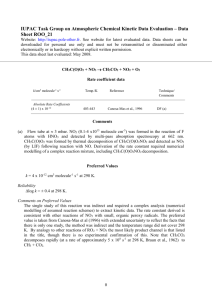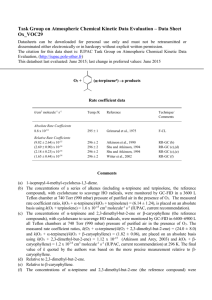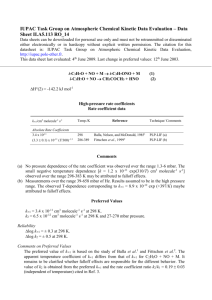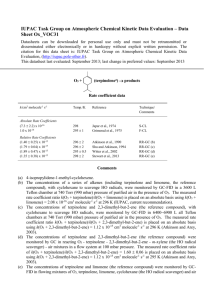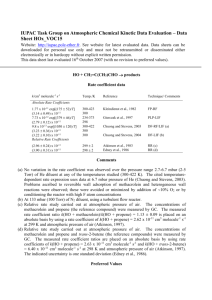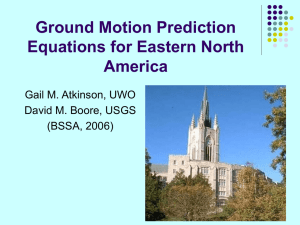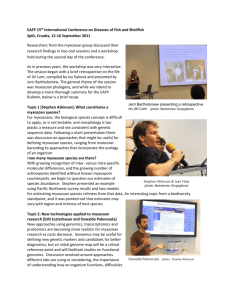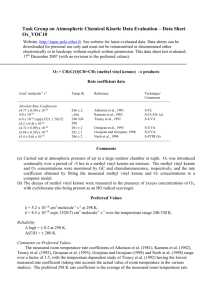Data Sheet HOx_VOC21
advertisement
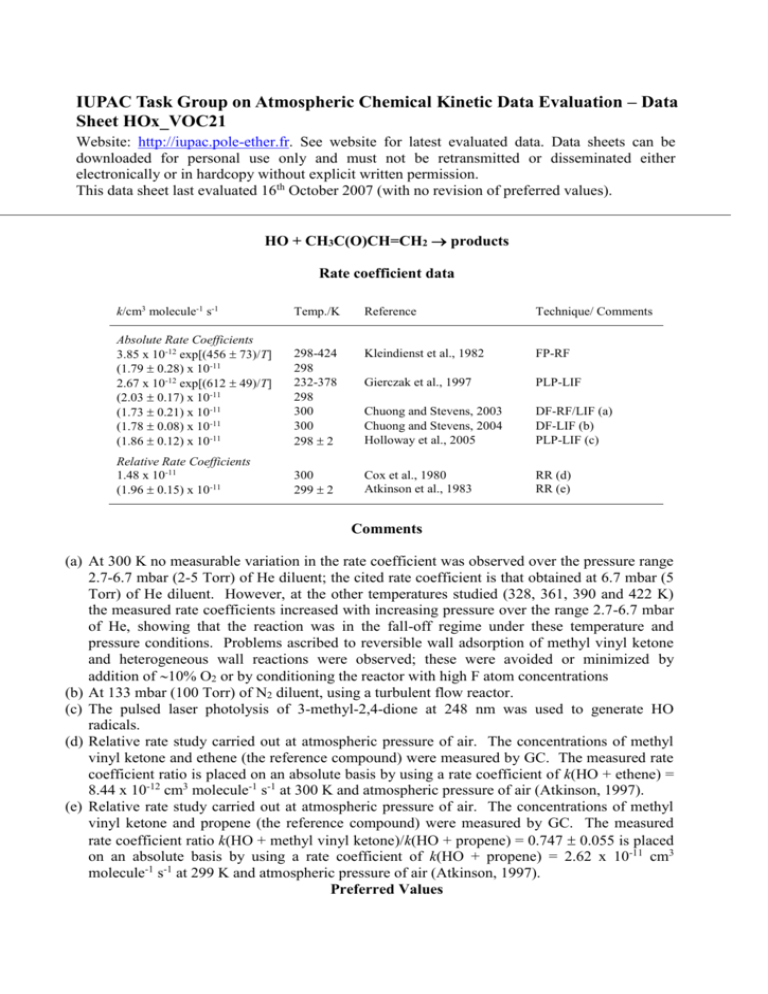
IUPAC Task Group on Atmospheric Chemical Kinetic Data Evaluation – Data Sheet HOx_VOC21 Website: http://iupac.pole-ether.fr. See website for latest evaluated data. Data sheets can be downloaded for personal use only and must not be retransmitted or disseminated either electronically or in hardcopy without explicit written permission. This data sheet last evaluated 16th October 2007 (with no revision of preferred values). HO + CH3C(O)CH=CH2 products Rate coefficient data k/cm3 molecule-1 s-1 Temp./K Reference Technique/ Comments Absolute Rate Coefficients 3.85 x 10-12 exp[(456 73)/T] (1.79 0.28) x 10-11 2.67 x 10-12 exp[(612 49)/T] (2.03 0.17) x 10-11 (1.73 0.21) x 10-11 (1.78 0.08) x 10-11 (1.86 0.12) x 10-11 298-424 298 232-378 298 300 300 298 2 Kleindienst et al., 1982 FP-RF Gierczak et al., 1997 PLP-LIF Chuong and Stevens, 2003 Chuong and Stevens, 2004 Holloway et al., 2005 DF-RF/LIF (a) DF-LIF (b) PLP-LIF (c) Relative Rate Coefficients 1.48 x 10-11 (1.96 0.15) x 10-11 300 299 2 Cox et al., 1980 Atkinson et al., 1983 RR (d) RR (e) Comments (a) At 300 K no measurable variation in the rate coefficient was observed over the pressure range 2.7-6.7 mbar (2-5 Torr) of He diluent; the cited rate coefficient is that obtained at 6.7 mbar (5 Torr) of He diluent. However, at the other temperatures studied (328, 361, 390 and 422 K) the measured rate coefficients increased with increasing pressure over the range 2.7-6.7 mbar of He, showing that the reaction was in the fall-off regime under these temperature and pressure conditions. Problems ascribed to reversible wall adsorption of methyl vinyl ketone and heterogeneous wall reactions were observed; these were avoided or minimized by addition of 10% O2 or by conditioning the reactor with high F atom concentrations (b) At 133 mbar (100 Torr) of N2 diluent, using a turbulent flow reactor. (c) The pulsed laser photolysis of 3-methyl-2,4-dione at 248 nm was used to generate HO radicals. (d) Relative rate study carried out at atmospheric pressure of air. The concentrations of methyl vinyl ketone and ethene (the reference compound) were measured by GC. The measured rate coefficient ratio is placed on an absolute basis by using a rate coefficient of k(HO + ethene) = 8.44 x 10-12 cm3 molecule-1 s-1 at 300 K and atmospheric pressure of air (Atkinson, 1997). (e) Relative rate study carried out at atmospheric pressure of air. The concentrations of methyl vinyl ketone and propene (the reference compound) were measured by GC. The measured rate coefficient ratio k(HO + methyl vinyl ketone)/k(HO + propene) = 0.747 0.055 is placed on an absolute basis by using a rate coefficient of k(HO + propene) = 2.62 x 10-11 cm3 molecule-1 s-1 at 299 K and atmospheric pressure of air (Atkinson, 1997). Preferred Values k = 2.0 x 10-11 cm3 molecule-1 s-1 at 298 K. k = 2.6 x 10-12 exp(610/T) cm3 molecule-1 s-1 over the temperature range 230-380 K. Reliability logk = 0.10 at 298 K. (E/R) = 200 K. Comments on Preferred Values The room temperature rate coefficients of Kleindienst et al. (1982), Atkinson et al. (1983), Gierczak et al. (1997), Chuong and Stevens (2003, 2004) and Holloway et al. (2005) are in good agreement, but are higher by 20-35% than the earlier relative rate measurement of Cox et al. (1980). The preferred 298 K rate coefficient is based on the room temperature rate coefficients of Atkinson et al. (1983), Gierczak et al. (1997) and Holloway et al. (2005). The temperature dependence measured by Gierczak et al. (1997) is accepted and the preexponential factor is calculated from the preferred 298 K rate coefficient and the temperature dependence. The products of the reaction of HO radicals with methyl vinyl ketone in the presence of NO have been investigated by Tuazon and Atkinson (1989). The reaction proceeds by initial addition of the HO radical to the carbon atoms of the C=C bond, forming (in the presence of NO) the intermediate hydroxyalkoxy radicals CH3C(O)CH(O)CH2OH and CH3C(O)CH(OH)CH2O, which decompose by the pathways: CH3C(O)CH(O)CH2OH CH3C(O)CHO + CH2OH CH3C(O)CH(O)CH2OH CH3CO + HOCH2CHO and CH3C(O)CH(OH)CH2O HCHO + CH3C(O)CHOH followed by reactions of CH2OH and CH3C(O)CHOH radicals with O2 to form HCHO + HO2 and CH3C(O)CHO + HO2, respectively. The first generation products are therefore HCHO + CH3C(O)CHO and HOCH2CHO + CH3CO (with the acetyl radical reacting to form peroxyacetyl nitrate [CH3C(O)OONO2; PAN] or HCHO (Tuazon and Atkinson, 1989; IUPAC, 2007)). Tuazon and Atkinson (1989) measured formation yields of methylglyoxal and glycolaldehyde of 25 8% and 64 16%, respectively, showing that initial HO radical addition occurs mainly at the terminal CH2 group (Tuazon and Atkinson, 1989). References Atkinson, R.: J. Phys. Chem. Ref. Data 26, 215, 1997. Atkinson, R., Aschmann, S. M., and Pitts Jr., J. N.: Int. J. Chem. Kinet. 15, 75, 1983. Chuong, B. and Stevens, P. S.: J. Phys. Chem. A 107, 2185, 2003. Chuong, B. and Stevens, P. S.: Int. J. Chem. Kinet. 36, 12, 2004. Edney, E. O., Kleindienst, T. E., and Corse, E. W.: Int. J. Chem. Kinet. 18, 1355, 1986. Gierczak, T., Burkholder, J. B., Talukdar, R. K., Mellouki, A., Barone, S. B., and Ravishankara, A. R.: J. Photochem. Photobiol. A: Chem. 110, 1, 1997. Holloway, A.-L., Treacy, J., Sidebottom, H., Mellouki, A., Daële, V., Le Bras, G. and Barnes, I.: J. Photochem. Photobiol. A: Chem. 176, 183, 2005. IUPAC,: http://iupac.pole-ether.fr, 2013. Kleindienst, T. E., Harris, G. W., and Pitts Jr., J. N.: Environ. Sci. Technol. 16, 844, 1982. Tuazon, E. C. and Atkinson, R.: Int. J. Chem. Kinet. 21, 1141, 1989. R ecom m endation K leindienst et al. (1982) A tkinson et al. (1983) G ierczak et al. (1997) C huong and S tevens (2003, 2004), 300 K only H ollow ay et al. (2005) 5 H O + C H 3 C (O )C H = C H 2 3 3 -1 -1 x k (c m m o le c u le s ) 4 10 11 2 1 2.0 2.5 3.0 3.5 1 0 0 0 /T (K ) 4.0 4.5
